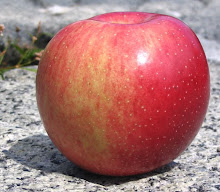
|
This attractive variety has a red blush over yellow green, accented by many tiny light lenticels. At its deepest the blush comprises darker and lighter streaks together.
The lenticels, which are dark green in the unblushed skin, crowd the bottom third of the fruit and grow sparse near the top.
Braeburn runs medium to large and is moderately ribbed. My sample is fragrant, firm, and (see the photo) glistening with wax.
 The flesh is creamy yellow and medium coarse.
Braeburn is satisfyingly crisp and juicy, with a mild, sweet
flavor.
The flesh is creamy yellow and medium coarse.
Braeburn is satisfyingly crisp and juicy, with a mild, sweet
flavor.
Although the tastes are mostly generic, there is some complexity and a hint of oranges and I wonder what else might come to light were there more balancing tartness.
Neither the flavor nor the sweetness is so concentrated as to cloy, and the
general effect is refreshing and not without interest.
Braeburn began life as a chance seedling found in a New Zealand orchard in the middle of the last century. It needs lots of sun, which may be one reason why Brogdale notes, "This particular clone quite often fails to mature fully in the UK."
This variety stores and travels extremely well.

I am working my way through a bag of these from the grocery store. They have a nice sweet taste with a slight zing. The best ones of the bag had a nice berry flavor to them. Overall the texture was more on the soft side although some were moderately crunchy. Overall not a bad apple to munch on in early Spring!
ReplyDeleteIndividual specimens of many apple varieties vary, but Braeburns seem to vary more than most, in my experience. I picked out some firm yet highly colored ones at the store a few weeks ago that were great--but since then my supermarket searches have yielded ones that are are either greener without the complexity or redder and verging on mealy....
ReplyDeleteJust enjoyed a very good New Zealand Braeburn. I've had many Braeburns over the years but never one with the spicy zing that this one had - still feeling the light sizzle on my tongue.
ReplyDelete@Steve: Sounds like you hit the sweet spot!
DeleteAlso, your report could be an entry in the hypothetical blog (suggested in jest by a reader who finds Braeburn to be especially variable) called "The Braeburn that I Ate Today."
I would agree with that reader! A good Braeburn is really fun to eat, with a lemony tartness and very crisp texture; but when they go south they still feel hard from the outside and thoroughly disappoint with their very mealy texture. Maybe we should stop trying to save them for out-of-season and eat them all at their peak!
ReplyDeleteAccording to a French study (2020):
ReplyDeleteBraeburn = Red Delicious x Sturmer Pippin
I would not have guessed that! Looks like a lot in that report, though I am not sure I have the technical chops to understand things like "Mendelian error."
ReplyDeleteApparently, I've found that report in Wikipedia.
DeleteAnd yes, it contains a vast amount of interesting data...
As far as I understand it, "Mendelian error" (ME) is an observable inheritance error (in some gene, in DNA, there's a mismatch between assumed parent and offspring):
it means either a wrong parenthood/child assumption (high ME numbers),
or a mutation (low ME numbers).
No wonder: nowadays, when you try to compare the genome of some 100-year-old cultivar with its 150-year definite parent one, probably you're actually comparing 2 mutants (sports).
In the report, the authors use ME to rule things out when determining ancestry.
DeleteThat's it:
Deleteif they match, they are related;
if they don't match (gene mismatches = "errors"), they're not related.